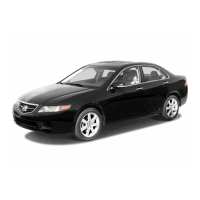CONTINUED
An infant must be properly
restrained in a rear-facing, reclining
child seat until the child reaches the
seat maker’s weight or height limit
for t he seat and the child is at least
one year old.
Only a rear-facing child seat provides
proper support for a baby’s head,
neck, and back.
Two types of seats may be used: a
seat designed exclusively for infants,
or a convertible seat used in the rear-
facing, reclining mode.
If placed
facing forward, an infant could be
very seriously injured during a
frontal collision.
A rear-facing child seat can be placed
in any seating position in the back
seat, but not in the front.
If the passenger’s front airbag
inflates, it can hit t he back of the
child seat with enough force to kill or
seriously injure an infant.
When properly installed, a rear-
facing child seat may prevent the
driver or a front passenger from
moving t he seat as far back as
recommended, or from locking the
seat-back in the desired position.
Protecting Infants and Small Children
Protecting Infants
Child Seat Type
Child Seat Placement
Do not put a rear-facing child seat in
a forward-facing position.
Never put a
rear-facing child seat in the front
seat.
Driver and Passenger Safety
35

